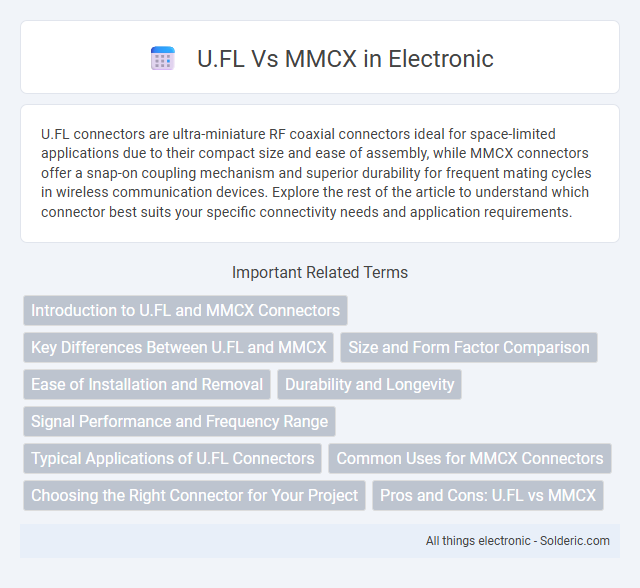U.FL connectors are ultra-miniature RF coaxial connectors ideal for space-limited applications due to their compact size and ease of assembly, while MMCX connectors offer a snap-on coupling mechanism and superior durability for frequent mating cycles in wireless communication devices. Explore the rest of the article to understand which connector best suits your specific connectivity needs and application requirements.
Comparison Table
| Feature | U.FL Connector | MMCX Connector |
|---|---|---|
| Connector Type | Micro coaxial RF connector | Micro-miniature coaxial RF connector |
| Size | 2.0 mm diameter | 3.0 mm diameter |
| Frequency Range | Up to 6 GHz | Up to 6 GHz |
| Durability (Mate Cycles) | Up to 30 cycles | Up to 500 cycles |
| Cable Type | Typically 1.13 mm or 1.37 mm coaxial cable | Typically 1.13 mm or 1.37 mm coaxial cable |
| Application | Embedded wireless devices, WiFi modules, GPS antennas | WiFi, GPS, cellular radios, test equipment |
| Locking Mechanism | Snap-on | Bayonet lock |
| Cost | Lower cost | Higher cost |
| Recommended Use | Space-constrained devices with limited connect/disconnect cycles | Applications requiring frequent connections and higher durability |
Introduction to U.FL and MMCX Connectors
U.FL connectors are ultra-miniature coaxial connectors designed for high-frequency signal transmission in compact devices such as smartphones and Wi-Fi modules, offering secure snap-on connection with a low profile footprint. MMCX connectors, slightly larger and more robust, provide 360-degree rotation capability and are commonly used in wireless communication systems, GPS devices, and antennas, supporting reliable RF signal integrity. Both connectors serve critical roles in RF applications, with U.FL favored for space-constrained designs and MMCX preferred for durability and ease of maintenance.
Key Differences Between U.FL and MMCX
U.FL connectors are ultra-miniature, designed for high-density PCB applications, offering secure snap-on connections with a 1.5 mm mating height. MMCX connectors provide a more robust solution with a 3 mm diameter, supporting 360-degree rotation and easy mating/demating ideal for flexible cable use. Your choice between U.FL and MMCX should consider space constraints, durability needs, and the type of antenna or device interface.
Size and Form Factor Comparison
U.FL connectors are significantly smaller than MMCX connectors, measuring approximately 2.0mm in diameter, making them ideal for compact devices where space is limited. MMCX connectors, with a diameter of around 3.0mm, offer a slightly larger form factor that provides increased durability and ease of handling in applications where size constraints are less critical. Your choice between U.FL and MMCX should consider the balance between miniaturization needs and mechanical robustness.
Ease of Installation and Removal
U.FL connectors offer superior ease of installation and removal due to their compact size and snap-on design, which requires minimal tooling and effort, ideal for tight spaces on PCBs. MMCX connectors, while slightly larger, provide robust locking mechanisms that ensure secure connections but may require more precise alignment and careful handling during installation. Your choice between U.FL and MMCX should consider the trade-off between ease of handling and connection stability in your specific application.
Durability and Longevity
U.FL connectors are compact and designed for low-power signals, but their durability is limited to approximately 30 mating cycles before performance degradation occurs. MMCX connectors offer superior longevity, supporting around 500 mating cycles with stable signal integrity, making them ideal for applications requiring frequent connections and disconnections. The robust mechanical design of MMCX connectors ensures consistent performance over time, outperforming the more delicate U.FL in terms of durability.
Signal Performance and Frequency Range
U.FL connectors generally provide excellent signal performance with low insertion loss up to 6 GHz, making them suitable for Wi-Fi and Bluetooth applications. MMCX connectors support a broader frequency range, often up to 6 GHz or higher, with robust signal integrity for RF and microwave systems. Both connector types ensure reliable transmission, but MMCX offers greater durability in high-frequency and demanding environments.
Typical Applications of U.FL Connectors
U.FL connectors are predominantly used in compact devices like smartphones, laptops, and IoT modules where space-saving and reliable RF connections are crucial. They excel in internal antenna connections for Wi-Fi, GPS, and cellular communication due to their small size and easy mating cycles. If your project requires tight integration of RF components within limited space, U.FL connectors provide efficient and robust solutions.
Common Uses for MMCX Connectors
MMCX connectors are commonly used in applications requiring reliable RF connections with compact size, such as GPS devices, mobile phones, wireless LAN equipment, and IoT modules. Their robust locking mechanism ensures stable performance in environments with frequent movement or vibration, making them ideal for wearables and automotive systems. Your projects benefit from MMCX connectors when durability and space-saving design are critical factors.
Choosing the Right Connector for Your Project
Choosing between U.FL and MMCX connectors depends on factors like size, frequency range, and mechanical durability. U.FL connectors offer compact size and are ideal for high-frequency applications up to 6 GHz but have limited mating cycles, making them suitable for permanent installations. MMCX connectors provide greater durability with up to 500 mating cycles and support frequencies up to 6 GHz, making them better for applications requiring frequent connections or disconnections.
Pros and Cons: U.FL vs MMCX
U.FL connectors offer compact size and low profile ideal for small devices but have limited mating cycles and lower durability compared to MMCX. MMCX connectors provide robust mechanical retention and higher mating cycles, making them suitable for applications requiring frequent connections, though they are bulkier than U.FL. Your choice depends on space constraints and the need for connector longevity in your specific application.
U.FL vs MMCX Infographic

 solderic.com
solderic.com